The morning of April 3, 2010 was a beautifully sunny one. We drove straight through Newport via the River Road where we saw some beautiful stands of Dutchman’s Breeches and they were flowering just profusely. They are really pretty with their little flower frond held high in the air. They made me stop and turn around they were that pretty. Since it was private property we didn’t take time to ask to get a picture because we were on the way somewhere.
Anyway, we continued on through Newport, PA on Route 34 south to New Bloomfield, turned left at the town square and continued on Route 274. About where the houses end at the edge of town, we turned right onto Huckleberry Road and about a half-mile down the road came to the Box Huckleberry Natural Area, land protected by the forest service.
The Box Huckleberry Natural Area is a 10-acre site in the Tuscarora State Forest.
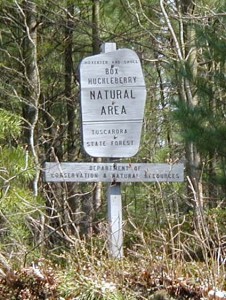
The Box Huckleberry Natural Area of the Tuscarora State Forest has been managed by the Pennsylvania Bureau of Forestry since 1974, and is located in Perry County, Pennsylvania. Route 34/274 are half a mile away and New Bloomfield is 1 1/2 miles away. Take the Newport/Route 34 exit of Route 322 and continue south on Route 34. When you turn onto Huckleberry Road there is a small pullout for a parking area. The creek across the road feeds into Trout Run.
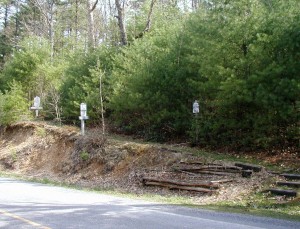
Walking up the steps into the natural area you come to a trail where there is a map posted. No pamphlets available. Rules and regulations are posted by the Forest Service. To be highlighted among these rules is that you shall do no picking of flowers according to the rules on forest products.
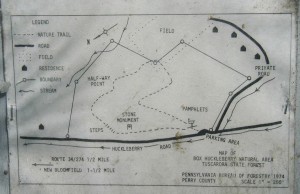
The trail is well-worn with pine needles, pine cones, leaves or moss covering the trail in places. It’s a short trail running maybe half a mile up and over a hill. In a few spots you could see the tire imprints of a mountain bike rider that rode through the trail recently.
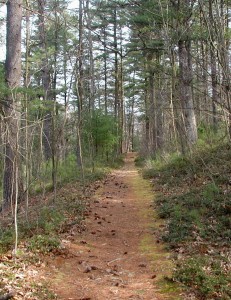
The nature trail has a moderate climb and a few steps in appropriate locations to help you up the trail.
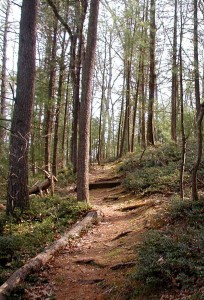
The Box Huckleberry, Gaylussacia brachycera, is like a low-growing blueberry. The plants are green everywhere with their evergreen leaves shining in the sunlight.
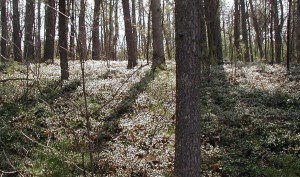
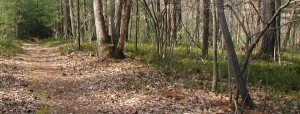
Small oval leaves are leathery to the touch, with a shiny slick upper surface and a paler rougher surface on the underside of the leaves.
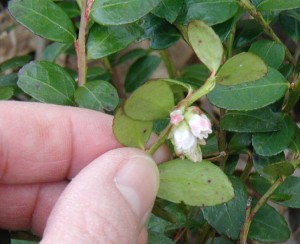
Huckleberry blossoms are just starting to come out now. The flowers are similar to blueberry blossoms because the bell-shaped white flowers hang in clusters.
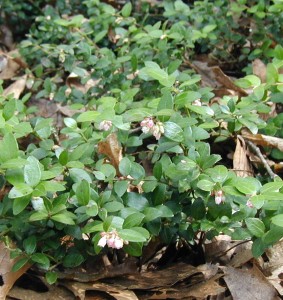

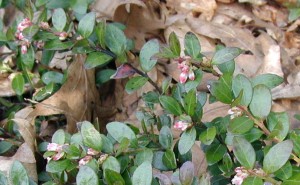
Most plants have tight pink buds for flowers, not opened blossoms. Blossoms that catch an early morning sun might be opening, but not very many huckleberries are blooming just yet.
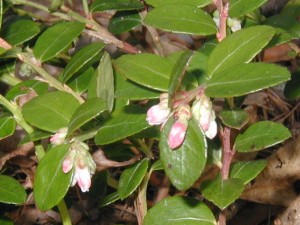


I came over here to find a trailing arbutus as I had never seen the “mayflower” before and it’s been reported to be at this location. Trailing arbutus, Epigaea repens, has rounded evergreen leaves and five pointed bell-shaped blossoms in pink or white. I combed the area in and around the pine trees trying to find trailing arbutus but with no luck.
A couple groups of striped wintergreen were close to the trail in the shaded areas, especially on the hillsides. This land is pretty much covered with white pine and hemlock which creates deep shade and the perfect type of area for the box huckleberry.
Box huckleberry has not spread to areas underneath the more open canopy of the deciduous trees on the far side of the hill. The areas with more sun reaching the ground, like the far side of the hill from the entrance, might be the natural limit of the huckleberry due to the lack of shade.
I found it interesting that the only known colony or plant in North Carolina is associated with mountain laurel, just as the PA plants are.
Besides the striped wintergreen we saw the single leaf of the dogtooth violet but no blooms, and wintergreen – some still with their red berries. Where the box huckleberry grows almost nothing else is growing as it heavily carpets the whole area. Rattlesnake-weed with its heavy, purple-veined leaf ribs were seen at the edge of the shady area near the entrance.
Box Huckleberry Natural Area Reference
A major curiosity is that the entire box huckleberry colony is actually one giant plant that is estimated to be at least 1300 years old! It grows by expansion of roots at a rate of about 6 inches per year. Currently, the New Bloomfield Box Huckleberry, as it’s referred to by the forest service, is about 8 acres in size. There’s another box huckleberry plant not too far from here that is reportedly over 13,000 years old, which makes these plants some of the very oldest organisms on the planet.
Worthy of protection, don’t you think? The box huckleberry has a threatened status in Pennsylvania and is protected by virtue of being in the State Forest.
Under Title 17 Pennsylvania Code, Part 1 Department of Conservation and Natural Resources, Subpart C State Forests, Chapter 21 General Provisions, under Forest Products part 21.31 Prohibitions. The following activities are prohibited…
Cutting, picking, digging, damaging or removing in whole or in part a living or dead plant, vine, shrub, tree or flower on State Forest land without written permission of the district forester or designee, except that edible wild plants or plant parts may be gathered without authorization if they are gathered for one’s own personal or family consumption. Dead and down wood for small camp fires may be gathered without prior authorization.
I would interpret that to mean that we can’t take any clippings or cuttings of the plants themselves, but we could come back and sample the fruit without getting in trouble. I wonder if huckleberries taste like blueberries…hmmm, maybe we’ll come back to this berry patch in June.
![Reblog this post [with Zemanta]](http://img.zemanta.com/reblog_e.png?x-id=107a9fb3-52cf-4f40-8152-337a9f65a975)
Dear Wildherb:
I am writing to request permission to use material from your website on our Literary and Cultural Heritage Map of Pennsylvania. The Pennsylvania Center for the Book has established an exhaustive website of people from or connected to Pennsylvania. On our Map, we have published biographies of over 1100 such people.
As an extension of our Map, we have also begun to commission articles on non biographical subjects: events from the past, food, music, and many others. Naturally, such articles need to be illustrated to encourage the general public and school children to read through the sometimes lengthy articles.
In our searches, we have found that your pictures of the box huckleberry plant would make excellent illustrations for an article on the Perry County box huckleberries we have received. We would like to ask you for permission post this material as part of the article with a photo credit of your choosing and a link to your site.
This extensive website is used for education, research, and entertainment. Penn State and the Pennsylvania Center for the Book are dedicated to using the Internet to further research and public education, and see this as a wonderful opportunity to do both.
The non-profit Pennsylvania Center for the Book was approved by the Library of Congress to begin its operation on January 1, 2000, joining 41 (now 50) other state centers for the book in the United States. We are supported by the University Libraries at the Pennsylvania State University in University Park. The mission of the Pennsylvania Center for the Book is to study, honor, celebrate, and promote books, reading, libraries, and literacy to the citizens and residents of the Commonwealth of Pennsylvania.
We have found that most of the people and companies we contact agree with the importance of our mission and in the value of the Map to children and to the general public. We hope that you concur and will grant us permission to use your material on a permanent basis. You may find one of our feature articles at http://pabook.libraries.psu.edu/palitmap/MartinGuitar.html to see what the finished pieces look like, along with a couple model photo credits.
Thank you for your time and consideration in helping us to promote Pennsylvania’s cultural heritage. Please respond by email, U.S. mail or telephone at your earliest convenience.
Sincerely,
Alan Jalowitz
Editor, Literary and Cultural Heritage Map of Pennsylvania
502 Paterno Library
University Park, PA 16802
acj2@psu.edu
814-865-9246
I’d be delighted. Contacting you via email.
Found the link to the Box Huckleberry Plant article at The Pennsylvania Center for The Book, called Pennsylvania’s Oldest Citizen. It includes a couple of photos from wildeherb!